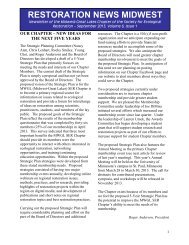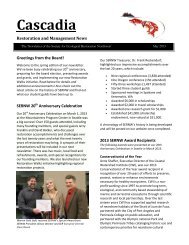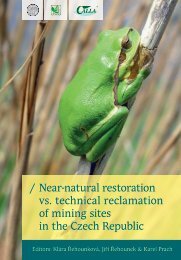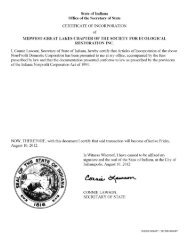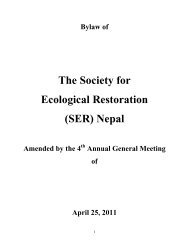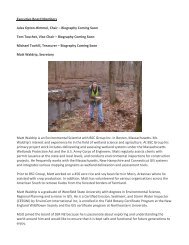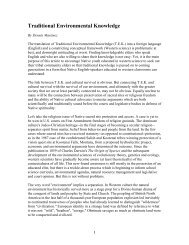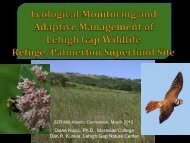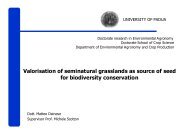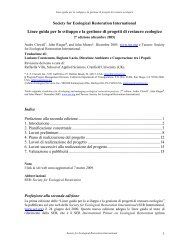THE WORLD CONFERENCE ON ECOLOGICAL RESTORATION
A Global Challenge - Society for Ecological Restoration
A Global Challenge - Society for Ecological Restoration
Create successful ePaper yourself
Turn your PDF publications into a flip-book with our unique Google optimized e-Paper software.
2005 The World Conference on Ecological Restoration 51<br />
derstand the effect of existing institutional actions, regulations and enforcement mechanisms had on<br />
long term ecological viability and/or recovery. I will present a powerpoint overview of two or three case<br />
studies, one the “Pittsburgh Hillsides” zoning study, two the “Clean Streams” initiative and three the<br />
“Rivertrails” project. I will show how this team of artists, scientists, planners and attorneys collaborated<br />
on creating visual, conceptual and social “tools” that aid and abet citizen involvement in the aesthetic recovery<br />
of the post industrial public realm.<br />
Keywords: art, terrestrial, aquatic, mapping, radical planning, policy.<br />
Rehabilitation os arsenical sulphidic gold mine. A case history at Stawell Gold<br />
mine, Victoria, Australia<br />
Comino 1 E., A.J.M. Baker 2 , A. Doronila 2 , L. Chibnall 3 , N. Casacuberta 4<br />
1 Dipartimento di Ingegneria del Territorio, dell’Ambiente e delle Geotecnologie, Politecnico di Torino. C.so Duca degli Abruzzi,<br />
24- 10129 Torino (Italy)<br />
2 School of Botany, The University of Melbourne, Parkville, VIC 3010, Australia<br />
3 Stawell Gold Ltd,<br />
4 Departament Ciències Ambientals, Universitat Autònoma de Barcelona Bellaterra (Barcelona). Spain<br />
This project was designed to develop ecologically sustainable methods of revegetating areas impacted by<br />
gold mining, a common resource exploitation in the state of Victoria, Australia. As toxic soils are poor or<br />
even difficult substrates for plants to grow on, the creation of a self-sustaining vegetation community on<br />
contaminated land requires the substrate to be suitable for plant growth. Chemical and physical analyses<br />
of substrate samples are a fundamental part of the planning and implementation of any rehabilitation<br />
project, providing vital information on the nutrient status, toxicity and structure of the substrates.<br />
The aims of this research were: to evaluate the growth of plants in different concentrations of calcium<br />
sulphate and tailings. To identify and quantify toxic metal and metalloid uptake in plants grown in different<br />
concentrations of tailings. To define the optimum chemical and physical conditions of soil cover for<br />
plant to grow over tailings bed. To identify chemical and physical changes in tailings after three years of<br />
being covered with three different treatments. The data obtained from this study are used to develop a<br />
strategy that integrates soil treatments with the selection of plant species that are tolerant to toxins or<br />
rehabilitation of mine wastes (tailings) at Stawell Gold mine, at present the largest gold mine operating in<br />
Victoria, Australia. The concentration of gold in the rock mined for 1km depth is about 5 g per ton. To<br />
extract the gold, the sulphidic rocks are crushed and processed, resulting in the production of finegrained<br />
tailings. These are pumped as a slurry into tailings lagoons and slowly dewater. The tailings are<br />
sulphidic wastes enriched with arsenic (about 2,000 ppm) and heavy metal toxins. The results obtained<br />
in this study, also show that tailings contain other secondary minerals aside from gypsum, further limiting<br />
their potential as a medium for plants growth and survival.<br />
Keywords: ecologically sustainable, gold mining, plants growth and survival.<br />
Influence of landscape structure on the effectiveness of Spanish agrienvironment<br />
schemes<br />
Concepción E.D., M. Díaz, R.A. Baquero<br />
Departamento de Ciencias Ambientales, Universidad de Castilla-La Mancha, E-45071 Toledo, Spain<br />
Recent work has suggested that the failure of some agri-environment (AG) schemes to restore biodiversity<br />
could be partially due to reduced recolonisation rates and/or source populations in simpler landscapes.<br />
We analyse whether the effectiveness of AG schemes (i.e., increase in species richness of birds, plants,<br />
bees, grasshoppers and spiders between paired fields with and without schemes) are influenced by landscape<br />
traits at the field scale and at the scale of the landscape surrounding fields. Selected landscape<br />
metrics were measured at the two scales: size and shape of focal fields and types of boundaries (field<br />
scale), and cover of land uses, length of three types of boundaries and measures of landscape structure<br />
in 500-m circular buffers around field centres (landscape scale). Landscape metrics were summarized by<br />
means of three Principal Component Analyses, one for field-scale metrics and two for landscape-scale<br />
metrics, one estimating landscape connectivity and the other the diversity and type of land uses. Species<br />
richness and landscape traits were measured in three study areas in Spain differing in landscape complexity<br />
(amount of natural vegetation interspersed within fields), following a sampling design developed in<br />
the V Framework project ‘Evaluating current European agri-environment schemes to quantify and improve<br />
nature conservation efforts in agricultural landscapes’ (EASY). Our results suggest that effects on<br />
landscape on effectiveness of AG schemes are non-linear, including threshold values of landscape complexity<br />
and saturation effects.<br />
Keywords: AG schemes, landscape structure, effectiveness, biodiversity.



